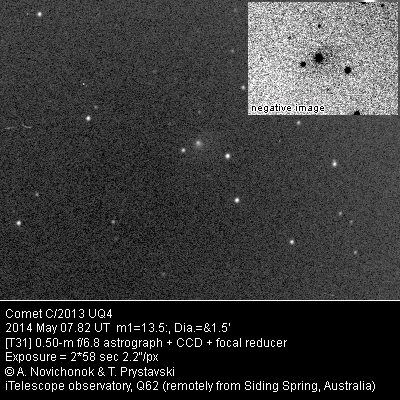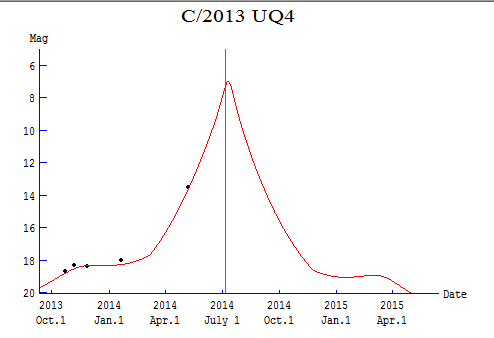Damoсloid asteroid 2013 UQ4 showed cometary activity
Damocloid asteroid 2013 UQ4 was discovered in the autumn of 2013. Observations carried out by A. Novichonok and T. Prystavski on May 07.82, 2014 revealed cometary activity of this object. In addition, this newly discovered comet is expected to be bright in the mid of summer, attaining magnitude up to 7 mag and having good conditions for observations in the Northern Hemisphere. 2013 UQ4 will pass perihelion on July 5th, 2014 at a distance of
A. Novichonok and T. Prystavski discovered cometary features of Damocloid asteroid 2013 UQ4 observing it low in the morning sky (at altitude 20 deg) using a 50-cm remote telescope (MPC=Q62, iTelescope observatory.
Object 2013 UQ4 was discovered on October 23rd, 2013 at 18.5 mag (68-cm telescope, Catalina Sky Survey). Observers did not admit any cometary activity during several months. Absolute magnitude H=12.9 which is proof that object is actually large with diameter of about 7-
Visually comet can be observed already, but the conditions are expected to get better. In May, 2014 comet can be found in the morning sky in constellation Cetus. In June it will move up north floating constellations Pisces and Andromeda. 2013 UQ4 will brighten up to 13.5-11.5 mag during May, attaining 8–9 mag by the end of June. In time of perihelion passage (June 5th, 2014), when comet will be at maximum brightness (7 mag predicted) best observation conditions will be just for northern observers. On July, 10th comet will have close approach to Earth (
Watch comet C/2013 UQ4 visually and submit your observations to CometBase!


Authors - T. Prystavski, A. Novichonok
backHost name: Jean Meeus
Comment: Why has the object not yet receive a cometary designation by the Minor Planet Center? For the MPC, it is still 2013 UQ4, not C/2013 UQ4. Jean Meeus
Host name: Marek Biely (Castor 98)
Comment: Congratulations, Artyom and Taras! Now it looks that the period is only 491 years, so the comet isn´t new from the Oort cloud. I´m a bit afraid that the comet will be very diffuse when it will be close to Earth. But that doesn´t mind very much because it probably will be binocular object. I look forward to this comet. Congratulations again!
Host name: H. Sato
Comment: Yes I also observed it as a comet by iTelescope T17. The total R-band magnitude was estimated as 14.5 within a circular aperture of radius 12".8. The outer coma was not imaged on 6 stacked images of 30-sec exposure.
